Beer isn’t just for sipping – it’s also a secret weapon in the kitchen. Whether you’re simmering a stew, braising meat, or making beer-battered fish, the right beer can seriously upgrade your dish. But not all beers are created equal when it comes to cooking. In this guide, we’ll break down which types of beer work best for different recipes, so your food tastes as good as it smells.

1. Guinness Draught Stout
Guinness Draught Stout is a dark Irish beer known for its distinctive smooth texture and creamy head. It is made using roasted barley, which contributes to its deep color and rich, complex flavor. The use of nitrogen in the carbonation process, instead of only carbon dioxide, gives it a velvety mouthfeel and the characteristic cascading effect when poured. This stout has a balanced taste profile, combining notes of roasted grains with mild bitterness and subtle sweetness. Its aroma typically carries hints of coffee and dark chocolate, making it a recognizable and unique beverage among stouts. Guinness Draught Stout is commonly served on tap or in cans and bottles that simulate the draft experience. It has become a popular choice in many pubs and homes, often enjoyed on its own or paired with a variety of foods. It is also sometimes used in cooking to enhance flavor in hearty dishes.
Key Highlights:
- Dark color and creamy head resulting from roasted barley and nitrogenation
- Smooth, velvety texture due to nitrogen-infused carbonation
- Distinct roasted flavor with mild bitterness and subtle sweetness
- Known for its cascading pour and long-lasting foam
- Widely available in tap, bottle, and can formats that preserve its unique texture
Best Used For:
- Pairing with rich, savory meals such as stews and roasted meats
- Incorporating into recipes for added depth, like beer-braised dishes
- Enjoying during casual gatherings or social events
- Sampling as an example of traditional Irish stout style
- Serving as a session drink due to its moderate strength and smooth finish

2. Sierra Nevada Pale Ale
Sierra Nevada Pale Ale is an American-style pale ale known for its well-balanced bitterness and bright citrusy aroma. The beer is medium-bodied with a distinct hop flavor that adds a layer of complexity to dishes. Its refreshing profile makes it ideal for cooking dishes that require a bit of bitterness without overpowering the other flavors. The hints of pine and citrus, combined with a clean finish, allow it to pair well with grilled meats, seafood, and even spicy dishes. Sierra Nevada Pale Ale is also useful for creating light, tangy sauces that can elevate the flavor of everything from stir-fries to marinades. It’s a versatile option for those looking to add a crisp, slightly hoppy edge to their cooking.
Key Highlights:
- Balanced bitterness with bright citrusy aroma
- Medium-bodied with clean finish
- Pine and citrus flavor notes
- Versatile for both savory and spicy dishes
- Enhances grilled and marinated foods
Best Used For:
- Grilled chicken and pork
- Spicy marinades and sauces
- Stir-fries and vegetable dishes
- Light seafood recipes
- Beer-battered vegetables
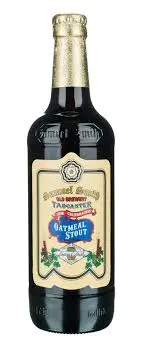
3. Samuel Smith’s Oatmeal Stout
Samuel Smith’s Oatmeal Stout is a traditional English stout brewed with oats in addition to barley malt, giving it a smooth, velvety mouthfeel. The malt-forward flavor profile includes rich notes of chocolate, coffee, and a slight sweetness from the oats. This stout is particularly useful in adding depth and complexity to both savory and sweet dishes. It’s a go-to option for braised meats, hearty stews, and rich sauces, as well as for desserts like chocolate cakes and brownies, where the dark, malty character enhances the sweetness of the dish. The creamy texture of this stout also helps in creating thick sauces and gravies that have a luxurious consistency. This beer works well for any dish that could benefit from a robust, malty infusion.
Key Highlights:
- Smooth, velvety texture from oatmeal
- Rich malt flavors with chocolate and coffee notes
- Slight sweetness balances bitterness
- Ideal for both savory and sweet applications
- Helps create thick, luxurious sauces
Best Used For:
- Beef stews and braised meats
- Chocolate-based desserts
- Rich gravies and sauces
- Beer-battered dishes
- Baking rich cakes and brownies
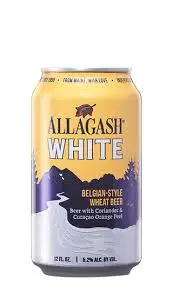
4. Allagash White
Allagash White is a Belgian-style witbier, brewed with a blend of coriander and orange peel, giving it a crisp and refreshing character. The light, citrusy flavor profile is paired with subtle spice notes, making it an excellent choice for delicate dishes that need a gentle touch. The effervescence of this beer helps elevate lighter dishes like seafood, poultry, and fresh salads, adding a refreshing tang without overpowering the natural flavors of the ingredients. The beer’s smooth, lightly spiced finish also works well for enhancing creamy sauces and vinaigrettes. Allagash White is particularly effective in recipes that benefit from a mild but flavorful beer presence, especially when paired with citrusy or herbal ingredients.
Key Highlights:
- Light, citrusy flavor with subtle spice
- Brewed with coriander and orange peel
- Effervescent and refreshing
- Enhances delicate dishes without overpowering
- Adds complexity to light sauces and vinaigrettes
Best Used For:
- Seafood dishes
- Poultry and grilled chicken
- Light pasta dishes
- Fresh salads and vegetable sides
- Fruit-based desserts

5. New Belgium Fat Tire
New Belgium Fat Tire is an amber ale with a well-balanced malt and hop profile. The beer offers a smooth, toasted malt flavor with hints of caramel and biscuit, making it an ideal choice for recipes that require a bit of richness. The light bitterness from the hops ensures that it complements hearty dishes like roasted meats, grilled sausages, and comfort foods without overpowering them. The beer’s medium body allows it to blend well in marinades and beer-based sauces, adding complexity and depth. Fat Tire’s malt-forward character also enhances savory pies and stews, where the richness of the beer pairs seamlessly with the other ingredients.
Key Highlights:
- Balanced malt and hop profile
- Toasted malt flavor with caramel and biscuit notes
- Medium-bodied with smooth finish
- Ideal for comfort foods and hearty dishes
- Blends well in marinades and sauces
Best Used For:
- Roasted vegetables
- Grilled sausages and meats
- Beer-braised dishes
- Savory pies and stews
- Beer-based sauces

6. Budweiser
Budweiser is a light American lager known for its clean and crisp taste. Its mild flavor and high carbonation make it a versatile ingredient in cooking, particularly when you need a beer that won’t overpower other flavors. Budweiser is ideal for dishes that require a light beer presence, such as seafood or delicate poultry dishes. The beer’s carbonation helps to tenderize meats in marinades and adds a crispness to batters when making beer-battered dishes. Its neutrality makes it a good base for light sauces and gravies, where the beer enhances the flavor without becoming the dominant element.
Key Highlights:
- Clean, crisp taste with mild flavor
- High carbonation aids in tenderizing meats
- Neutral flavor profile
- Ideal for light dishes and beer-battered foods
- Versatile in creating light sauces and gravies
Best Used For:
- Beer-battered fish and vegetables
- Light chicken marinades
- Seafood dishes
- Light sauces and gravies
- Baking light bread and rolls

7. Chimay Blue (Grande Réserve)
Chimay Blue, a Belgian Trappist beer, is a dark strong ale with a deep brown color and reddish hues. The beer’s full-bodied nature and smooth texture make it ideal for hearty, savory dishes like stews and braised meats. Its slightly sweet, malty character can also complement desserts, particularly those with dark chocolate. The dark fruit notes of Chimay Blue enhance rich sauces, adding layers of complexity to dishes like beef bourguignon and lamb shanks. It’s an excellent beer to incorporate into cooking for those looking to add a bold, flavorful profile to their recipes.
Key Highlights:
- Deep amber color with dark fruit and caramel flavors
- Full-bodied with smooth texture
- Slight sweetness and malty character
- Excellent for rich savory dishes
- Adds depth to sauces and stews
Best Used For:
- Beef bourguignon
- Braised meats like lamb shank
- Rich stews and casseroles
- Dark chocolate desserts
- Beer-based marinades
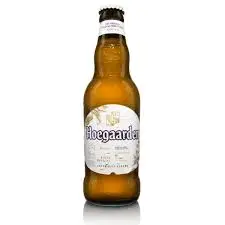
8. Hoegaarden
Hoegaarden is a Belgian wheat beer that is light, refreshing, and subtly spiced. Brewed with orange peel and coriander, it offers a delicate citrus aroma and a smooth, creamy body. Its gentle flavor and moderate carbonation make it perfect for dishes that require a light touch, such as salads, seafood, and poultry. The beer’s spice notes also work well in cream-based sauces or vinaigrettes, where it adds a refreshing, citrusy twist. Hoegaarden is a good choice for those who want to add a hint of zest without overwhelming the dish. Its mild profile and versatility make it an excellent ingredient in cooking, especially for bright, fresh dishes.
Key Highlights:
- Light, refreshing with citrus and spice notes
- Brewed with orange peel and coriander
- Moderate carbonation with smooth body
- Subtle citrus aroma
- Perfect for light and fresh dishes
Best Used For:
- Seafood dishes and salads
- Poultry and chicken dishes
- Cream-based sauces and vinaigrettes
- Light pasta dishes
- Bright citrus desserts
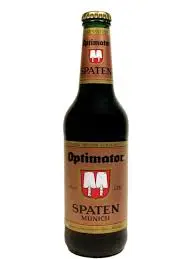
9. Spaten Optimator
Spaten Optimator is a German doppelbock beer, known for its rich, malty flavor and robust body. It has a deep brown color with hints of dark fruit, caramel, and a touch of toasty bread. The strong malt profile of Spaten Optimator makes it a great match for hearty dishes such as roasted meats, sausages, and stews. Its slightly sweet and roasted flavor complements these dishes, while its fullness and smooth finish add richness to sauces and gravies. This beer is ideal for braising meats or enhancing the depth of flavor in slow-cooked recipes, where its complex profile can shine through.
Key Highlights:
- Deep brown color with rich malty flavors
- Hints of dark fruit, caramel, and toasted bread
- Strong malt profile with slightly sweet taste
- Full-bodied and smooth finish
- Ideal for slow-cooked and braised dishes
Best Used For:
- Roasted meats and sausages
- Slow-cooked stews and casseroles
- Rich gravies and sauces
- Beer-braised meats
- Baking rich bread or pastries
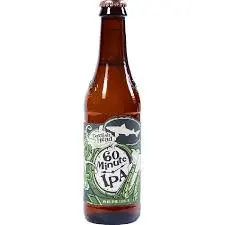
10. Dogfish Head 60 Minute IPA
Dogfish Head 60 Minute IPA is an American IPA that balances bitterness with a fruity hop character. This beer is known for its vibrant hop flavors, with hints of pine, citrus, and tropical fruit. Its moderate bitterness makes it an excellent choice for dishes that require a punch of flavor but not an overwhelming bitterness. The beer works particularly well with grilled foods, such as burgers or barbecued meats, and can also enhance the flavor of spicy dishes. Its light body and hop-forward character make it a versatile ingredient for creating sauces, glazes, or marinades that need an added kick.
Key Highlights:
- Balanced bitterness with vibrant hop flavors
- Notes of pine, citrus, and tropical fruit
- Moderate alcohol content
- Light body and crisp finish
- Excellent for grilled and spicy dishes
Best Used For:
- Grilled meats like burgers and steaks
- Barbecued dishes
- Spicy marinades and glazes
- Beer-battered fried foods
- Stir-fries and Asian-inspired dishes

11. Bell’s Two Hearted Ale
Bell’s Two Hearted Ale is a popular American IPA, recognized for its intense hop bitterness and citrus aroma. With flavors of pine, grapefruit, and floral notes, it’s a bold and flavorful beer that can stand up to hearty dishes. The beer’s medium body and clean finish make it a versatile ingredient in cooking, where it can add complexity to sauces, braises, or grilled meats. The hop-forward profile complements spicy and smoky flavors, making it a great match for barbecue or chili. Bell’s Two Hearted Ale is a great choice for adding a citrusy hop punch to recipes that need a bold beer presence.
Key Highlights:
- Intense hop bitterness with citrus aroma
- Notes of pine, grapefruit, and floral flavors
- Bold and flavorful with clean finish
- Medium body ideal for complex dishes
- Great for adding a hop punch to recipes
Best Used For:
- Grilled meats and barbecue
- Spicy chili and stews
- Beer-battered seafood
- Marinades for rich meats
- Stir-fries and smoked dishes
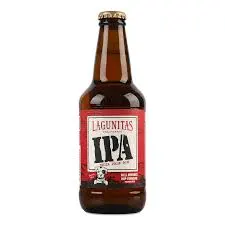
12. Lagunitas IPA
Lagunitas IPA is a West Coast-style India Pale Ale known for its bold hop flavor and assertive bitterness. The beer features a blend of piney, resinous hops with hints of citrus and tropical fruit, creating a balanced yet potent taste. Its medium-bodied nature and hop-forward profile make it a great match for dishes that need an intense, flavorful beer presence. Lagunitas IPA is perfect for adding an extra layer of complexity to barbecue, grilled meats, and spicy foods. It can also enhance savory dishes like chili or stews, where the bitterness of the beer complements the richness of the ingredients.
Key Highlights:
- Bold hop flavor with piney and citrus notes
- Assertive bitterness with tropical fruit undertones
- Medium-bodied with clean finish
- Ideal for grilled meats and barbecue
- Adds depth to savory, spicy dishes
Best Used For:
- Grilled meats and burgers
- Barbecue dishes
- Spicy foods like chili or tacos
- Beer-based marinades and sauces
- Stir-fries and Asian-inspired dishes

13. Pilsner Urquell
Pilsner Urquell is a classic Czech pilsner, recognized as the world’s first pilsner, brewed since 1842. Its clean, dry finish and delicate malt sweetness make it ideal for cooking. This beer adds a subtle hop character to dishes without overwhelming the palate. It’s a great choice for cooking lighter dishes, such as seafood, chicken, and salads, where the crispness can brighten up the flavors. Pilsner Urquell is also an excellent beer for making light batters, as its carbonation gives a delicate, crispy texture to fried foods.
Key Highlights:
- Light and crisp with subtle hop bitterness
- Dry finish with delicate malt sweetness
- Ideal for lighter dishes and seafood
- Enhances the freshness of salads
- Perfect for beer batters and fried foods
Best Used For:
- Seafood and chicken dishes
- Light salads and dressings
- Beer-battered fish and chips
- Grilled vegetables
- Baking light breads and rolls

14. Founders All Day IPA
Founders All Day IPA is a session IPA with a lighter body and a more approachable bitterness than traditional IPAs. It offers bright citrus and pine flavors, with a crisp, clean finish. The lower alcohol content makes it ideal for use in cooking, especially for dishes that need a bit of hop flavor without being too overpowering. Founders All Day IPA is great for grilled foods, particularly burgers and sausages, as well as for creating marinades and dressings. Its crisp, refreshing quality also pairs well with seafood and lighter salads.
Key Highlights:
- Lighter body with a sessionable alcohol content
- Bright citrus and pine flavors
- Crisp, clean finish with moderate bitterness
- Refreshing and versatile in cooking
- Ideal for grilling and light dishes
Best Used For:
- Grilled burgers and sausages
- Marinades and dressings
- Seafood and light salads
- Beer-battered vegetables
- Stir-fries and tacos
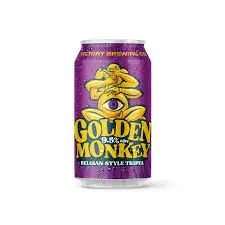
15. Victory Golden Monkey
Victory Golden Monkey is an American-brewed Belgian-style tripel, offering a smooth, fruity sweetness and a slightly spicy finish. It’s a strong beer with complex flavors, offering notes of honey, pear, and a mild spiciness. The higher alcohol content and sweetness make it a great match for rich dishes, especially those with a bit of heat. Victory Golden Monkey pairs wonderfully with spicy Asian cuisine, roasted meats, or even creamy pasta dishes. The fruity character and malty sweetness can also enhance the flavors of desserts, such as fruit tarts or spiced cakes, adding an unexpected depth to your baking.
Key Highlights:
- Fruity sweetness with honey and pear notes
- Slightly spicy finish with a strong body
- Higher alcohol content and complex flavors
- Pairs well with rich, spicy dishes
- Enhances the flavor of desserts and baked goods
Best Used For:
- Spicy Asian dishes like Thai curry
- Roasted meats and poultry
- Creamy pasta sauces
- Beer-based glazes and marinades
- Fruit tarts and spiced cakes

16. Brooklyn Lager
Brooklyn Lager is an American Amber Lager with a well-balanced taste that combines the bitterness of hops with the sweetness of malt. Its deep amber color and crisp finish make it a versatile beer for cooking. Brooklyn Lager pairs well with a range of dishes, from grilled meats to pizza. The malty sweetness can enhance sauces and glazes, while the hop bitterness provides balance. Its smooth texture also makes it ideal for marinating meats or creating beer-based dressings. Whether used in braising, roasting, or grilling, this beer adds complexity to a wide variety of recipes.
Key Highlights:
- Well-balanced with malty sweetness and hop bitterness
- Deep amber color with crisp finish
- Versatile for a wide range of dishes
- Enhances sauces, glazes, and marinades
- Smooth texture for beer-based dressings
Best Used For:
- Grilled meats and barbecue
- Pizza and Italian dishes
- Beer-based marinades and glazes
- Braised meats and roasts
- Beer-battered dishes
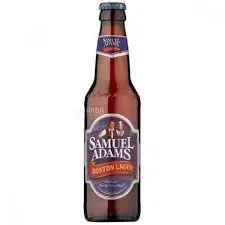
17. Samuel Adams Boston Lager
Samuel Adams Boston Lager is an American lager that offers a balanced, malty sweetness paired with a mild hop bitterness. Its medium body and smooth finish make it an excellent choice for a variety of cooking applications. The beer’s rich malt profile complements roasted meats, while its slight bitterness enhances grilled vegetables. Boston Lager also works well in braising and slow-cooking recipes, where it adds depth to sauces and stews. Its versatile flavor profile makes it a great all-purpose cooking beer for both savory and mildly sweet dishes.
Key Highlights:
- Balanced malty sweetness with mild hop bitterness
- Medium body with smooth finish
- Rich malt profile that complements roasted meats
- Ideal for braising and slow-cooking recipes
- Versatile for both savory and sweet dishes
Best Used For:
- Roasted meats and poultry
- Braised dishes and stews
- Grilled vegetables
- Beer-based marinades and sauces
- Beer-bread and cake recipes
Conclusion
Choosing the right beer for cooking can elevate your dishes and bring out new layers of flavor that you might not expect. Whether you’re using a light lager to brighten up a salad or a rich stout to add depth to a hearty stew, the key is to match the beer’s characteristics with the dish you’re preparing. Don’t be afraid to experiment and use these beers to enhance marinades, sauces, or even desserts! Remember, the best beer for cooking is one that complements your ingredients without overpowering them. So next time you’re in the kitchen, grab a beer, have fun with it, and see how it can transform your meals. Cheers to tasty meals and great brews!
FAQ
1. Can I use any beer for cooking?
While you can technically use any beer for cooking, it’s best to choose one that complements the flavors of your dish. Lighter beers work well for delicate dishes, while richer beers like stouts are ideal for hearty meals. Be sure to consider the beer’s bitterness, sweetness, and body before adding it to your recipe.
2. What type of beer is best for marinades?
Lighter beers like pilsners or wheat beers are great for marinades because their subtle flavors don’t overpower the meat. However, darker beers such as stouts or porters can add depth and richness, making them perfect for braised meats and rich cuts.
3. Can beer enhance the flavor of desserts?
Yes! Beers with malt-forward flavors, like brown ales or porters, can add complexity to cakes, brownies, and even ice cream. The slight bitterness in darker beers also balances the sweetness of many dessert recipes, giving them a unique twist.
4. Do I need to cook off the alcohol when using beer in cooking?
While some recipes call for cooking the alcohol off, not all do. It depends on the dish and your preferences. If you want to reduce the alcohol content, you can simmer the beer for a few minutes before adding it to your recipe.
5. What’s the difference between using beer and wine in cooking?
Beer tends to add a more earthy or malty flavor profile, while wine often brings acidity and fruity notes. Both can enhance a dish, but beer generally works better in hearty, savory recipes, while wine is commonly used in lighter or more delicate dishes.
6. Can I use craft beer for cooking, or should I stick with standard beers?
Craft beers can be great for cooking, especially if you want to experiment with unique flavors. Just keep in mind that they often have more intense flavors than standard beers, so be sure to choose one that complements the dish you’re making.
7. How do I know which beer pairs best with my dish?
The key is balancing the flavors of the beer with your dish. Light beers are great with salads or seafood, while richer beers like stouts pair well with hearty meats and stews. Think of it like wine pairings: consider the body, sweetness, and bitterness of the beer in relation to the flavors of your food.
8. Is it necessary to use a full bottle of beer when cooking?
Not necessarily! You can use part of a bottle, depending on the recipe. If you have leftover beer, simply store it in the fridge for future use, but keep in mind that it may lose its freshness after a few days.

Leave a Reply